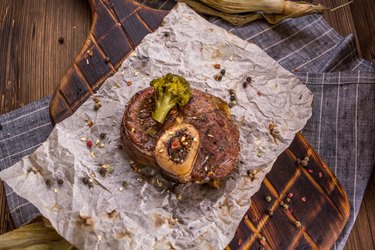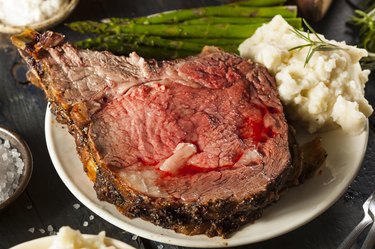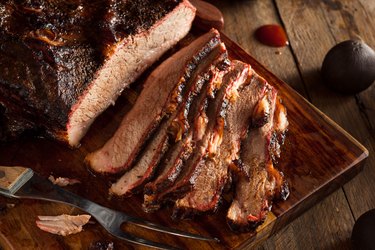Certain cuts of beef are tougher than others because of the muscle and connective tissue. When the meat is heated up too much or for too long, it can become tough. This is because heat can make the muscle fibers contract. When the meat becomes too tough, you need to know how to tenderize cooked meat.
If you want to soften an already-cooked tough roast, you can pound it, cut it against the grain, add a marinade or commercial tenderizing agents, or braise the meat. The USDA says to heat cooked beef again to at least 165 degrees Fahrenheit to stop harmful bacteria from growing.
Cooking a nice roast beef sounds great in theory, but sometimes the end result is a tough, chewy cut of meat. Fortunately, there are several techniques you can use to tenderize cooked roast beef so you end up with delicious, melt-in-your-mouth slices every time.
Why Roast Beef Can Turn Out Tough
There are a few common reasons roast beef can turn out tough and chewy rather than tender
-
Cut of meat – Certain cuts like eye of round are very lean and lack the fat marbling that helps keep meat tender, Choosing a well-marbled cut like ribeye is ideal for roast beef,
-
Overcooking – Cooking the roast beef too long results in meat fibers that contract and squeeze out moisture. This leads to dry, tough meat.
-
Slicing with the grain – Slicing parallel to the muscle fibers makes chewing difficult Always slice perpendicular to the grain.
-
Not resting – Allowing the cooked roast to rest for 10-15 minutes allows juices to redistribute evenly throughout the meat. Skipping this step means dry meat.
Effective Ways to Tenderize Cooked Roast Beef
If your roast beef has turned out a bit tough and chewy, don’t worry! You can still salvage it and achieve tender, juicy slices using the following techniques:
Slice Extremely Thin Against the Grain
Slicing the cooked roast beef as thinly as possible across the grain makes it easier to chew.Aim for 1/8 inch thick or less. Use a very sharp knife and take your time to slice evenly. The thinner the slice, the more tender it will be.
Break Down Fibers with a Meat Mallet or Tenderizer
Using a meat mallet, meat tenderizer tool, or even a fork, you can break down the tough muscle fibers in cooked roast beef. Gently pound or scrape the surface to help shorten the fibers without completely destroying the structure of the meat.
Simmer in Liquid
Simmering slices of cooked roast beef in a little beef broth, red wine, or sauce for 15-20 minutes more will impart moisture and further break down fibers. The acid in wine or vinegar gives an extra tenderizing boost.
Shred and Sauté
If all else fails, shred or chop the roast beef into very small pieces. Then, quickly sauté the shredded meat in a hot pan with oil until slightly crispy on the edges. The smaller pieces will be much more tender. Use for tacos, sandwiches, pasta sauce, etc.
Pound and Bread
After thinning the slices with a mallet, coat in flour, egg wash, bread crumbs, and pan fry until crisp. The breading gives a tender and juicy contrast to the beef. Use this method for beef cutlets.
Make Ground Beef
For extremely stubborn roast beef, dice or grind it into ground beef consistency. Cook with spices and sauces in dishes like chili, pasta Bolognese, shepherd’s pie, etc. where texture isn’t as much of a factor.
How to Cook Roast Beef for Maximum Tenderness
Follow these top tips to end up with tender, juicy roast beef every time:
-
Choose well-marbled cuts like ribeye, tenderloin, or prime rib. The fat keeps it moist.
-
Season well and bring to room temperature before roasting.
-
Use a meat thermometer and remove from oven at 135°F for medium-rare doneness.
-
Do not overcook! 140°F internal max for medium doneness.
-
Allow to rest for 10-15 minutes before slicing to redistribute juices.
-
Slice across the grain as thinly as possible. Enjoy immediately for best texture.
Frequently Asked Questions
How long does it take to tenderize cooked roast beef?
Tenderizing techniques like pounding, shredding, or simmering should only take about 15-30 minutes. Thin slicing may provide immediate tenderization. Marinating 8-12 hours before cooking will tenderize through the whole roast.
What is the best cut of roast beef for tenderness?
Ribeye, tenderloin, and prime rib cuts have the most marbling and fat content. This keeps them tender and moist, even when cooked beyond medium-rare doneness. Cuts like eye of round are very lean so can turn out tougher.
Can you over tenderize roast beef?
It is possible to over-tenderize roast beef if you pound or shred it too small. It can turn mushy in texture. Go gently until you reach the desired tenderness level. Thin slicing across the grain is the safest tenderizing method.
Should you tenderize roast beef before cooking?
Yes, light tenderizing before cooking is ideal. Use a meat mallet or tenderizer to gently break down some fibers or marinate overnight. This will allow seasonings to penetrate deeper. Avoid over-tenderizing raw meat or it may become mushy.
How can I save my roast beef dinner?
If the cooked roast beef is tough, quickly sauté shredded meat in a pan to crisp it up. Make beef cutlets or kabobs by pounding thin slices and breading/frying. Simmer in broth or red wine sauce to impart moisture. Turn leftovers into chili or Bolognese sauce.
Tender, delicious roast beef is easy to achieve. Follow the proper techniques when cooking, slicing, and tenderizing roast beef. With a variety of effective tenderizing methods, you can salvage a tough roast and still end up with mouthwateringly tender slices in just minutes. Master these simple tricks for roast beef perfection every time.

Pound or Cut It Up
The basic methods for tenderizing beef make meat more tender — even cooked beef. A meat mallet can be used to pound the beef, which breaks down the muscle fibers and makes the steak more tender.


Most of the time, flank steak and skirt steak are cut against the grain. This makes the meat easier to chew and less tough. Cutting the meat into small cubes or thin slices helps moisture and tenderizing products to work more effectively.
Add Marinade or Tenderizer
Marinating a tough steak or other piece of beef can make it more tender, according to Michigan State University. Choose marinades that are acidic, such as a marinade containing vinegar or citrus.


According to the USDA, beef can be marinated in the refrigerator for up to five days. Cut the cooked beef into thin strips to help the marinade penetrate the meat fibers to soften them.
Although commercial tenderizing products might help, theyre less effective on cooked beef than raw meat. Their tenderizing improves exposed surfaces of the meat, so the middle will remain tough. Using an injector designed for marinades or tenderizer can help these solutions penetrate the meat.

